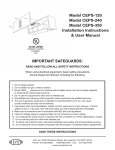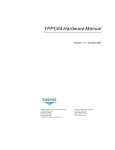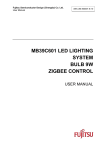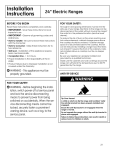Download Controller - E & S Technologies
Transcript
Controller Model 5084/5084e User’s Manual About ION Systems ION Systems develops, manufactures, and markets system solutions to manage electrostatic charge. As the world's largest provider of electrostatics management products and services, ION improves its customers' business results by providing a total solution to their electrostatic discharge and electromagnetic interference challenges. ION Systems is a wholly-owned subsidiary of Illinois Tool Works (ITW), and is located in Alameda, California. For more information about ION Systems visit www.ion.com or call 800-367-2452. ION Systems is ISO 9001 and ANSI ESD S20.20. © 2010 ION Systems, Inc. 19-5084-M-01 Rev 1 Contents 1 Description .......................................................................... 1 1.1 Controller Model 5084(e) ......................................................................... 2 1.2 Connectors, Controls, and Indicators....................................................... 3 1.3 Handheld Terminal................................................................................... 6 1.4 Power Requirements ............................................................................... 7 2 Installation ........................................................................... 9 2.1 Unpacking and Inspection...................................................................... 10 2.2 Controller Mounting................................................................................ 11 2.3 Controller Wiring .................................................................................... 12 2.4 Junction Box Wiring ............................................................................... 14 3 Setup & Operation............................................................. 15 3.1 Local Controller Setup ........................................................................... 16 3.2 Handheld Terminal Menus..................................................................... 19 3.3 Alarm Conditions.................................................................................... 23 3.4 Status Output Connector ....................................................................... 24 4 Maintenance ...................................................................... 25 4.1 Fuse Replacement................................................................................. 26 4.2 Adjustment............................................................................................. 27 5 Specifications.................................................................... 29 6 Warranty & Service ........................................................... 31 19-5084-M-01 Rev 1 1 Description 1.1 Controller Model 5084(e) 1.2 Connectors, Controls, and Indicators 1.3 Handheld Terminal 1.4 Power Requirements 19-5084-M-01 Rev 1 1 1.1 Controller Model 5084(e) The Controller Model 5084(e) sets the operating parameters and powers up to eighty ceiling emitters or AeroBars and can adjust on and off parameters of up to 10 seconds for sequenced bipolar operation. Timing and output can be programmed through the Handheld Input Module Model 5080. Two different versions of the 5084 Controller available from ION Systems: the standard 5084 and the enhanced 5084e. Throughout this manual, the different controller versions are referenced as follows: • 5084 applies to the standard (non-enhanced) model • 5084e applies to the enhanced model • 5084(e) applies to both the standard and enhanced models 19-5084-M-01 Rev 1 2 1.2 Connectors, Controls, and Indicators Front Panel Connections Item Function Positive timing on LED is lit during the on time of the positive (+) power cycle Positive timing off LED is lit during the off time of the positive (+) power cycle Negative timing on LED is lit during the on time of the negative (-) power cycle Negative timing off LED is lit during the off time of the negative (-) power cycle Reset switch Rockerswitch that resets the alarm indicators. This switch does not affect the operation of the emitter alarm indicators. Handheld Terminal Input Connector Modular connector for attaching the handheld terminal input cable to the 5084(e) Controller Table 1. Front Panel Connections Figure 1. Controller Front Panel 19-5084-M-01 Rev 1 3 Top Panel Connections Item Function Emitter output connectors (J11 and J12) Supply power to emitters: Pin 1 - Ground Pin 2 - Emitter Logic Control Line (±10V) Pin 3 - Emitter Alarm line (+5V) Pin 4 - 24 VAC Status output connector (J100) Alarm status output control: Pin 1 - Relay Output: Normally Open 4-20 mA Output: (-) Pin 2 - Relay Output: Common 4-20 mA Output: (+) Pin 3 - Relay Output: Normally Closed 4-20 mA Output: N/A Fuses (3) Control - 1/4 Amp. Type 5x20 mm Normal Blow Alarm - 1/4 Amp. Type 5x20 mm Normal Blow 24 VAC - 3.15 Amp. Type 5x20 mm Slow Blow Table 2. Top Panel Connections Figure 2. Controller Top Panel 19-5084-M-01 Rev 1 4 Bottom Panel Connections Item Function Power switch Rocker switch on the power entry module to turn on/off power to the Controller Fuse drawer Requires two 2 Amp. Type 5x20 mm Slow Blow fuses Table 3. Bottom Panel Connections Figure 3. Controller Bottom Panel 19-5084-M-01 Rev 1 5 1.3 Handheld Terminal The Handheld Terminal Model 5080 provides direct access to the internal processor in the Controller. The cursor on the Handheld Terminal displays itself as a flashing “o” on top of the character where it is positioned. When you first enter a screen, the cursor will be positioned in the first changeable field location at the farthest to the left of the display. The cursor can be moved across the screen by using the right (>) or left (<) arrow keys. When you key in new values, the cursor automatically moves to the next position to the right. The non-operational emitter's Alarm LED will be on. Figure 4. 5080 Handheld Terminal The Handheld Terminal allows initial Controller setup, monitors the Controller while in operation, and provides added security. When the Handheld Terminal is disconnected from the Controller none of the operational parameters can be altered. 19-5084-M-01 Rev 1 6 1.4 Power Requirements Caution: The use of improper input voltage may result in damage to the unit. Verify the input voltage setting on the fuse drawer before applying power to the unit. For safety, the use of extension cords is not recommended. The 5084(e) Controller must be installed within 6 feet of a properly grounded receptacle. If no such receptacle exists, one must be installed following the applicable building and National Electrical Code requirements. To reduce the risk of electric shock, this equipment has a grounding type plug that has a third (grounding) pin. This plug will only fit into a grounding type power outlet. Do not alter the plug in any way. The 5084(e) Controller has a variable power input setting depending on how the fuse drawer on the end panel is installed. The fuse drawer is located above the power plug connector on the bottom of the controller. Before inserting the power plug connector, verify that the correct power setting is displayed in the fuse drawer window. By default, the fuse drawer is set to 230V. If the setting is not correct, slide out the fuse drawer and reset it so that the proper setting is displayed in the window. 19-5084-M-01 Rev 1 7 19-5084-M-01 Rev 1 8 2 Installation 2.1 Unpacking and Inspection 2.2 Controller Mounting 2.3 Controller Wiring 2.4 Junction Box Wiring 19-5084-M-01 Rev 1 9 2.1 Unpacking and Inspection Upon receipt of this system, inspect all packages and report any visible damage directly to the shipper. As the system components are unpacked, inspect each one carefully for any physical damage that may have occurred during the shipping process. Do not attempt to install or apply power to any damaged equipment. If your system is to be installed by ION Systems personnel, they will perform this incoming inspection. 19-5084-M-01 Rev 1 10 2.2 Controller Mounting The 5084(e) Controller is supplied in a wall mount package. The rear panel of the controller has two key hole cutouts 12 inches (305 mm) apart, center to center, for mounting purposes. The wall material will determine the style of mounting screw to be used. For safety considerations, the mounting system used should be able to support approximately four times the weight of the controller (10 lb x 4 equals 40 lb). Examples: • Single thickness sheet metal wall (approximately 3/64 inches thick) -- use #12 x 3/4 inch sheet metal screws. • Sheet metal faced wall with 1/4inch thick metal honeycomb center -- use #12 sheet metal screws through entire wall thickness. • Double wall sheet rock wall -- use 1/4 inch molly bolts. • Install the mounting screws to the proper depth and place the 5084(e) Controller in position. 19-5084-M-01 Rev 1 11 2.3 Controller Wiring A number of different wiring methods may be used with the 5000 Series Ionization System. The method used will usually depend on facilities requirements. The principle method involves the use of 4conductor #22 AWG round cable between the 5084(e) Controller and a number of junction boxes. From the junction boxes, emitters are connected using 4-conductor #26 AWG flat style cable and modular connectors. Refer to Figures 5 and 6 when wiring up the controller: Figure 5. System Wiring Diagram 19-5084-M-01 Rev 1 12 Figure 6. Emitter Interconnect Cable 19-5084-M-01 Rev 1 13 2.4 Junction Box Wiring The figure below shows the wiring detail for a modular cable junction box. The cable going to the Controller is a 4 conductor cable that is terminated to an AMP Industries CPC connector. When connecting the spade lugs to the junction box screw terminals, care should be taken to insure none of the lugs are shorted together before installing the cover on the junction box. Also note that the white wire from the Controller is connected to the yellow terminal on the junction box. If present, the White and Blue terminals in the junction box have No Connections (NC). (Note that not all junction boxes have blue and white terminals). Figure 7. Junction Box 19-5084-M-01 Rev 1 14 3 Setup & Operation 3.1 Local Controller Setup 3.2 Handheld Terminal Menus 3.3 Alarm Conditions 3.3 Alarm Conditions 3.4 Status Output Connector 19-5084-M-01 Rev 1 15 3.1 Local Controller Setup The 5084(e) Controller parameters are set using the Handheld Terminal. The ionization system may be composed of one to a maximum of 32 ionization zones, each controlled by a single 5084(e) Controller. Each Controller can control from one to a maximum of eighty emitters. The 5084(e) Controller switches the Positive and Negative Emitters on and off according to the time setting in the Positive / Negative Emitter menu. Alarm conditions occur when there is an emitter failure (Model 5084e only). The Handheld Terminal can be connected or disconnected to or from the Controller with power on. After the Handheld Terminal is connected to the Controller, powered up and initialized, the opening menu will appear. By pressing the appropriate function keys (see Keys and Functions section), the desired menus may be selected for viewing. Handheld Terminal Keys and Functions Keys The Handheld Terminal provides a set of thirty keys and a 4 line LCD screen display. The keys enable the user to input operational data, initiate Controller menus and to audit status conditions. There are three function keys (F1, F2, F3), two on / off keys, eleven numeric key pad keys, dedicated function keys (Status, Password, Positive Emitter, Negative Emitter, Alarm Delay), an Escape key (Esc), four cursor keys and an Enter key. The following list defines the functions of each of these keys (see Figure 4 Handheld Terminal): 19-5084-M-01 Rev 1 16 Function Keys • F1 (not used at present) • F2 (not used at present) • F3 used for reinitialization of stored operating parameters. Reinitialization occurs when F3 is the first key selected during power up. Caution: Using the F3 key to reinitialize the Controller will result in the loss of all settings made during calibration. The Controller will default to 5084 non-enhanced operation. On / Off Keys • On: Turns a function on when selected. • Off: Turns a function off when selected. Numeric Key Pad • Zero thru nine and “.” (decimal point) Dedicated Function Keys • Status: Initiates Status Menu. • Password: Initiates Password Menu. • Positive Emitter: Initiates Positive Emitter Menu for entering Positive on and off Times and Positive Output. • Negative Emitter: Initiates Negative Emitter Menu for entering Negative on and off Times and Negative Output. • Alarm Delay: Initiates Alarm Delay menu for entering the number of cycles of continuous alarm line active before qualifying the alarm condition as a real alarm. • Cursor Keys: (^,V,<,>) used to sequence through menus. • Esc Key: Used to cancel an operation. • Enter Key: Used to enter data. 19-5084-M-01 Rev 1 17 Functions When you change and enter a value or condition, that change is made immediately. There is no additional save operation. When a numeric value such as a password, time or percent is entered, the new value is keyed directly over the existing value. The Enter key must then be pressed to send the new value to the Controller. If you leave a screen or window without pressing the Enter key, the original value is maintained. However, when you use a Condition key that turns a function on or off, you need only press the On or Off key on the Handheld Terminal. You do not need to press the Enter key. 19-5084-M-01 Rev 1 18 3.2 Handheld Terminal Menus Password The following items are displayed by pressing the Password button. To change any operating parameters for the 5084(e), the password key must be pressed and the proper password entered. The 5084(e) recognizes two types of passwords, the Operator Password and the Upgrade/Master Password. For information on the Upgrade/Master Password, please contact ION Systems ([email protected]). To input the Operator Password: 1. Press the Password key. The symbol “>” preceding a small flashing square is displayed. 2. Enter the Operator Password 1 2 3 on the numeric keypad followed by the Enter key. (The numbers will not appear onscreen.) If the password is correct, the Handheld Terminal will display the message: “>Accepted”. 3. The "^" and "v" keys can be used to scroll to the other Password menu items, “Mode Selection” and “Zone number” which are described below. Mode Selection With the proper upgrade password, the 5084E/PD mode can be selected to enable the alarm functions of the Controller. To change the Controller mode, press the Password key and use the V key to move to “Mode Selection.” Use the > key to select 5084 or 5084e. 19-5084-M-01 Rev 1 19 Zone Number The zone number parameter is not applicable with this equipment. Status Display the following items by pressing the Status key: Emitter Failure (Model 5084e only): The Emitter Failure indication will display either “yes” or “no” based on the Emitter’s operational condition. If “yes” is displayed, one or more of the emitters controlled by the present Controller has failed. As the sensing line of all emitters is daisy-chained, you must determine the location of the failed emitter by a visual inspection of the emitter installation. When you have completed your entry and pressed the Enter key, the cursor will move back to the first field location. The value displayed should be the value you previously input. This indicates that the value was valid and accepted. To change the value, enter new values and press the Enter key. Alarm Function (Model 5084e only): Setting to off overrides the emitter failure Alarm condition. Audible Alarm (Model 5084e only): Controls the Alarm beeper. When set to off, the beeper will not sound when an alarm condition exists. The visual Alarm LED will still indicate an alarm condition. Auto Shutoff (Model 5084e only): When set to on, all emitters will be shut down (turned off) in the event of any emitter failure. If set to off, the emitters will continue to operate, but the Alarm will still function. (ION Systems recommends setting to off). 19-5084-M-01 Rev 1 20 Emitter Count: Indicates how many emitters are connected to the Controller. This value must be entered manually and has no affect on Controller operation. Ver / PROM SN: Identifies the Controller software version and PROM serial number. EPROM/RAM ERROR: Will indicate “yes” if an EPROM or RAM error exists. Positive Emitter and Negative Emitter Two dedicated function keys provide access to the menus that set desired emitter timing and power output: POS EMITTER and NEG EMITTER: Time on and time off as well as Pos Output (in %) and Neg Output (in %). The time range of the Positive / Negative on time is 0.1 to 9.9 sec. The time range of the Positive / Negative off time is 0.0 to 9.9 sec. The power range of the Output Level is 0 to 100%. Alarm Delay The Alarm Delay can be set between 0 to 128. The number of delays is used to count the number of completed pos/on_off and neg/ on_off cycles wherein the Alarm line is continuously active. Alarm flags will be raised depending on the mode set for the Controller. 19-5084-M-01 Rev 1 21 System Timing The table below indicates suggested initial settings for the timing and output levels of the 5000 Series Ionization System. Values are set using the 5080 Handheld Terminal. These values were obtained from measurements obtained in ION Systems test facility. Values listed are for both laminar and non-laminar airflow conditions. The airflow was measured at workbench level, a height of 36 inch (91 cm). Airflow On Time Off Time Output Level 50 fpm laminar 2.50 1.50 50.00 100 fpm laminar 1.50 1.00 25.00 10 fpm, non laminar 4.00 2.50 75.00 25 fpm, non laminar 3.50 2.00 55.00 Table 4. Airflow Settings Note: These values will vary according to the actual environment. 19-5084-M-01 Rev 1 22 3.3 Alarm Conditions The 5084(e) Controller signals an emitter alarm condition by flashing the red front panel alarm LED. If the audible alarm is set to on, it will sound. Note that an alarm condition is not signalled at the controller until an emitter alarm has been sustained for the number of on/off cycles defined by the Alarm Delay setting. An emitter alarm indicates that one or more emitters have failed to function or that a wiring problem exists. The emitter in alarm condition will be identified by its alarm light (center LED). 19-5084-M-01 Rev 1 23 3.4 Status Output Connector The alarm status from the Status Output Connector (J100) is as shown in the table below. Alarm Active Alarm Inactive Brownout Current Loop 20 mA 4 mA 0 mA Relay Contact (J1001-J1002) closed open closed Relay Contact (J1002-J1003) open closed open Table 5. Alarm Status Conditions For additional information on the Status Output Connector see 1.2 Connectors, Controls, and Indicators section. 19-5084-M-01 Rev 1 24 4 Maintenance 4.1 Fuse Replacement 4.2 Adjustment There are no user-serviceable parts inside this Controller. Any unauthorized service will void the warranty and may result in additional repair charges. Caution: These instructions are for use by qualified maintenance personnel only. To avoid personal injury or damage to the equipment, do not perform any maintenance other than that contained in these instructions. 19-5084-M-01 Rev 1 25 4.1 Fuse Replacement Fuse Type Location(s) ION Systems P/N Schurter P/N 1/4 amp 5x20 mm Normal Blow Control Line and Alarm Line 28-1445 034.1510 2 amp 5x20 mm Slow Blow 120/240 VAC Line 28-1450 034.3120 3.15 amp 5x20 mm Slow Blow 24 VAC Line 28-1455 034.3122 Table 6. Fuse Replacement Parts 19-5084-M-01 Rev 1 26 4.2 Adjustment Use a Charged Plate Monitor (CPM) Model 280A (available from ION Systems), to adjust the 5000 Series’ ionization components. The test method used to adjust emitters is described in detail in the ANSI / ESD Standard STM3.1-2000 and the Instruction Manual for the Model 280A. The test setup is shown in below. Figure 8. Charged Plate Monitor Test Setup 19-5084-M-01 Rev 1 27 19-5084-M-01 Rev 1 28 5 Specifications Controller Model 5084 Power 24W + 1W per emitter Input 100-240 VAC ±10%, 50 or 60 Hz voltage-selectable and fuse-protected Output 24 VAC, ±10 VDC control signal Output Signal -10 to +10 VDC, controls output level for each polarity Capacity 80 emitters or bars Timing Control Ionization on and off cycles for each polarity (0-9.9 seconds) User Interface Handheld Terminal Model 5080 Indicators Power on, alarm, positive/negative emitter on/off, local communication Dimensions 15L x 4.5D x 6.75H in. (38.1 x 11.4 x 17.1 cm) Weight 9.25 lb (4.2 kg) Certifications Controller Model 5084e (The 5084e meets all the specifications of the 5084) Alarm Audible and/or visual (LED) indicates emitter failure; audible alarm is on/ off switchable Alarm Reset Switch provided on front panel User Interface Handheld Terminal Model 5080 or Facilities Monitoring System 19-5084-M-01 Rev 1 29 19-5084-M-01 Rev 1 30 6 Warranty & Service ION Systems provides a limited warranty for the Controller Model 5084(e) to be free from defects in material or workmanship for a period of two years from the date of receipt or installation. ION Systems liability under this warranty is limited to replacing or repairing any unit, returned by the purchaser, which has not been subjected to misuse, neglect, repair, alteration, or accident. In no event shall ION Systems be liable for collateral or consequential damages. To obtain service under this warranty, please contact ION Systems Technical Support ([email protected] or 510-217-0470). 19-5084-M-01 Rev 1 31 19-5084-M-01 Rev 1 32 Notes 19-5084-M-01 Rev 1 33 Notes 19-5084-M-01 Rev 1 34 1750 North Loop Road Alameda, CA USA 94502 Tel: 510-217-0600 Fax: 510-217-0484 Toll free: 800-367-2452 Sales services: 510-217-0460 Tech support: 510-217-0470 [email protected] [email protected] [email protected] [email protected] www.ion.com 19-5084-M-01 Rev 1



























































